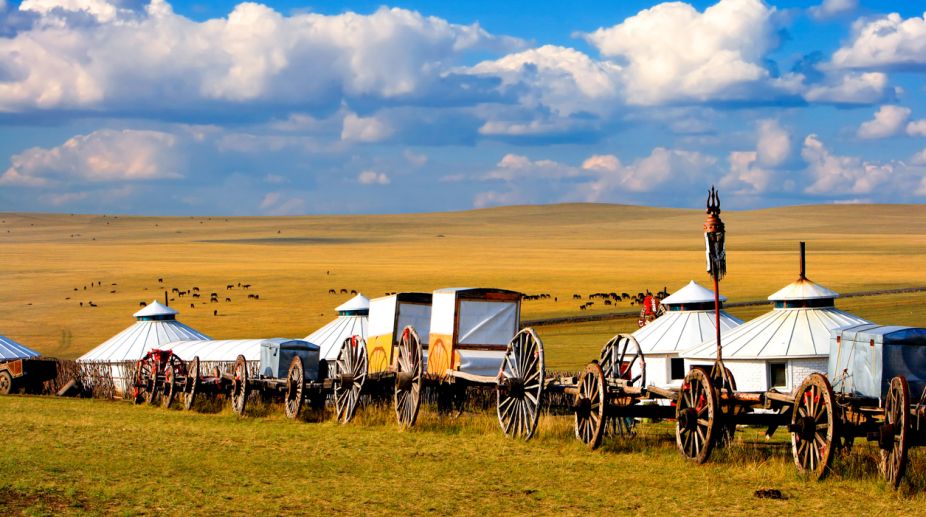Alia Bhatt stuns fans with beach pics and Thailand adventures!
Alia Bhatt treats fans to glimpses of her Thailand getaway, featuring beach moments, family time, and adventurous activities like jet skiing.

Representational Image (Photo: Getty Images)
How well do you know about Mongolia? People who have never visited Mongolia think that we still live in a ger (national dwelling) and ride horses to reach our schools or workplaces. However, the country, with a population of only 3 million, 60 thousand, according to the 2015 data, has been developing rapidly, with new additions, such as the Shangri-La Hotel, iMax movie theatre, Porsche showroom and Louis Vuitton brand store, to its capital city, Ulaanbaatar, which is home to about 1 million, 300 hundred people.
Geographically, Mongolia is located in North-East Asia and shares a 4.673-kilometre (km)-long border China in the south and 3485-km-long border with the Russian Federation in the north. The country is located at an average altitude of 1580 metres above sea level.
Advertisement
1. Mongolians still live in a ger today
Advertisement
Yes, we do and we don't as well. A ger is a portable, round tent covered with skins or felt and used as a dwelling by the nomads. A stove is placed in the middle of the ger for heating and cooking.
However, today almost half of the population live in apartments and houses. People prefer houses than ger in the countryside too. Hence, most tourist camps operating in Mongolia offer ger housing to visitors, enabling the guests to observe the sky through its roof window.
2. Mongolians ride horse for transportation
The truth is we do not ride horses often. Even herders ride motorcycles or vehicles in the countryside instead of horses nowadays. However, it is easy to find horses in Mongolia while tourist companies organise horse treks regularly. Moreover, horse is a sacred animal, and Mongols harbour a variety of spiritual beliefs regarding them.
Moreover, the mare's milk is processed into the national beverage, 'airag.'
In Mongolia, each horseman selects the best horse from their herd and takes it to the race during the Naadam festival. Horse racing is one of the 'three manly sports.' Mongolian races are long, up to 30 km and can involve thousands of horses.
3. Mongolia is the least vegan place in the world
Mongolia is definitely the country for meat lovers. We consume meat throughout the year, as we face harsh weather conditions, which have affected the traditional diet. Mongols mainly eat beef, mutton, horse meat and goat meat. It is popular to eat horse meat during the extremely cold Mongolian winter, as it provides more calories, which help to keep the body warm.
However, Mongols prefer not to eat meat during the summer. If you visit a herder family, you will notice that they eat dinner at around 5-6 pm local time and drink yogurt or boiled milk before they go to sleep. Meat is mostly cooked or used in soups. Spices and vegetables are not served often in the nomadic family.
In recent years, families living in cities have realised that eating too much meat is unhealthy, especially for those who are not working outdoors.
Therefore, the food and meals served in the countryside and city are quite different. Modern families in cities focus on healthy food by eating different types of vegetables and vegan food. You can find all vegetables from every store in Ulaanbaatar City, while there are plenty of vegan restaurants offering good choices in a country of meat lovers.
4. Mongolia is a dangerous place to travel
Absolutely no! The truth is that Mongolia is a lot safer than many other places that people travel, if you don't do anything silly. The only thing you should be aware of pickpocketing when you exploring the busy streets of Ulaanbaatar City. Mongolians are usually curious of foreigners and love trying to communicate with you, even if they can’t speak English.
5. Mongolia is part of China
The truth is that Mongolia is not part of both China and Russia. Mongolia is a landlocked sovereign state in Central Asia and proudly has its own language, culture, currency, parliament, and president.
In the 16th century, Tibetan Buddhism began to spread in Mongolia, being further led by the Manchu-founded Qing Dynasty, which absorbed the country in the 17th century. By the early 1900s, almost one-third of the adult male population were Buddhist monks. After the collapse of the Qing Dynasty in 1911, Mongolia declared independence from the Qing Dynasty, and in 1921, established de facto independence from the Republic of China.
Shortly thereafter, the country came under the control of the Soviet Union, which had aided its independence from China. On Nov 26, 1924, Mongolia declared itself as an independent country, with the adoption of its first Constitution. Mongolia has and will never be a part of China.
After the anti-Communist revolutions of 1989, Mongolia conducted its own peaceful democratic revolution in early 1990. This led to a multi-party system, a new Constitution of 1992 and transition to a market economy.
Advertisement